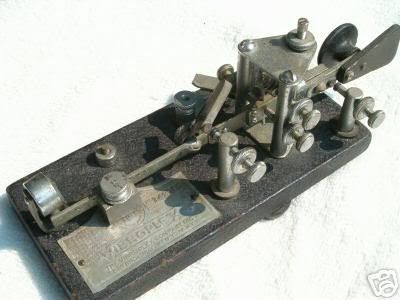One of my recent eBay winnings arrived today, my 1945 Vibroplex Zephyr. The Zephyr is one of the rarer Vibroplex keys, though most people who see one will assume it is a Champion — a very common key.
They wouldn't be far from the truth, as the Zephyr is a key that didn't really have a market. The key was smaller, the width was 3 inches rather than the standard 3-1/2 for the Original and Champion models. Other than the narrower width, the only other difference was the addition of a circuit closer. The Champion had no circuit closer. At the time the Champion and Zephyr were introduced (1939), keys without a circuit closer were usually deemed “radio keys.” The circuit closer was a necessity on a key that was used in a telegraphic circuit.
The problem with the Zephyr was it was priced exactly the same as the Vibroplex Original. The Original had a cast pivot frame and damper, the Champion and Zephyr used stamped steel parts for the pivot frame and damper. The Champion/Zephyr were cheaper to build since they eliminated the castings (other than the base).

So who would buy a Zephyr? The slightly narrower base might attract some folks, but the Blue Racer was actually narrower, if width was the issue.
The Zephyr that arrived today was bought worth the money, but it needed some work. I'm betting the guy who sold it photographed the key to not highlight its “issues.” Judge for yourself.
The pivot frame on the key consists of two triangular piece of steel. Each has a threaded collar pressed into it, and each collar holds a trunion pin. It's these pins that hold the main shaft of the key in place so it can swing back and forth.
The collars that hold the trunion pins (top and bottom plates) had been dislocated from both plates. The bottom trunion screw is missing, and it was replaced with a brass screw. The keying lever alignment was a mess, the collars were kinda stuck above and below the pivot shaft on the keying lever, held in place for the most part by sheer luck. The keying lever was so far out of kilter that the end of the shaft didn't hit the damper wheel, but hit the damper frame. The square weight on the keying lever was almost touching the Vibroplex ID tag.
That explains why it had such a cheap price on it.
The good news is that all the pieces were there, and I was able to actually reassemble the key in the manner it was supposed to be set up. The collars are a press fit into the triangular metal plates, and with the help of some an cyanoacrylate adhesive (Krazy Glue). I pressed both back in their proper places, and the adhesive will permanently bond them.
The ID plate looked corroded and green, but then I realized what was going on — during World War II, brass was diverted to other war production needs, so the Vibroplex ID plate for a while was no real brass, but stamped tin painted to look like brass. The color wore off quickly, and the tag on the Zephyr has only a hint of any brass coloring. The tag isn't rusted or damaged, which is more good news.
I did some preliminary cleaning on the key, and its going to look at least fair. Lots of dirt and nicotine. With the exception of a lower trunion screw, the key is complete. I will still need to do a thorough cleanup and Tarn-X the contacts, but that won't take too long.
The Zephyr won't ever be a museum piece, but its a not-so-common key that's worth keeping.
-30-
